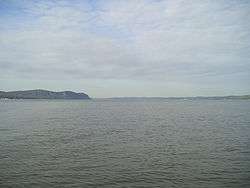Tappan Zee
| Tappan Zee | |
| Estuary | |
 Northern Tappan Zee | |
| Name origin: Tuphanne, Lenape term thought to mean "cold water".[1] Zee, Dutch for Sea. | |
| Country | United States |
|---|---|
| State | New York |
| Tributaries | |
| - left | Croton River, Pocantico River |
| - right | Sparkill Creek |
| Source | Hudson River, by way of Haverstraw Bay |
| - location | Croton-on-Hudson, New York |
| - elevation | 0 ft (0 m) |
| - coordinates | 41°10′03.64″N 73°53′54.65″W / 41.1676778°N 73.8985139°W |
| Mouth | North River (Lower Hudson) |
| - location | Dobbs Ferry, New York |
| - elevation | 0 ft (0 m) |
| - coordinates | 41°00′47.20″N 73°53′28.81″W / 41.0131111°N 73.8913361°WCoordinates: 41°00′47.20″N 73°53′28.81″W / 41.0131111°N 73.8913361°W |
| Length | 10.5 mi (17 km), North-South |
| Width | 3 mi (5 km), East-West |
| Depth | 52 ft (16 m) |
| NOAA Nav Chart | 12343[2] |
The Tappan Zee (/ˌtæpən ˈziː/; also Tappan Sea or Tappaan Zee) is a natural widening of the Hudson River, about 3 mi (5 km) across at its widest, in southeastern New York in the United States. It stretches about 10 mi (16 km) along the boundary between Rockland and Westchester counties, downstream from Croton Point to Irvington. It derives its name from the Tappan Native American sub-tribe of the Delaware/Lenni Lenape, and the Dutch word zee, meaning a sea.[3]
Flanked to the west by high steep bluffs of the New Jersey Palisades in the Hudson Valley, it forms something of a natural lake on the Hudson about 10 mi (16 km) north of Manhattan. Communities along the Tappan Zee include Nyack on the western side as well as Ossining and Tarrytown on the eastern side. It is crossed by the Tappan Zee Bridge, opened in 1955 and about 3.1 mi (5 km) long, connecting Nyack and Tarrytown.
On September 14, 1609, the explorer Henry Hudson entered the Tappan Zee while sailing upstream from New York Harbor. At first, Hudson believed the widening of the river indicated that he had found the Northwest Passage. He proceeded upstream as far as present-day Troy before concluding that no such strait existed there.

The Tappan Zee is mentioned several times in Washington Irving's famous short story, "The Legend of Sleepy Hollow". The tale is set in the vicinity of Tarrytown, in the area near Irving's own home at Sunnyside.
See also
External links
| Wikimedia Commons has media related to Tappan Zee. |
References
- ↑ Borough of Old Tappan – History of Old Tappan. Accessed July 15, 2013.
- ↑ NOAA Navigational Chart #12343, Hudson River: New York to Wappinger Creek. 19th Edition, corrected though Oct-05. Available as a NOAA Raster Navigational Chart at the NOAA Office of Coast Survey RNC Downloads website.
- ↑ Melvin, Tessa. "If You're Thinking of Living In/Tarrytown; Rich History, Picturesque River Setting", The New York Times, August 21, 1994. Accessed December 30, 2007. "The Dutch called this point, the river's widest, the Tappan Zee — Tappan probably for a group of Indians and Zee meaning "sea" in Dutch."